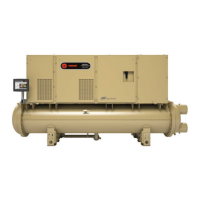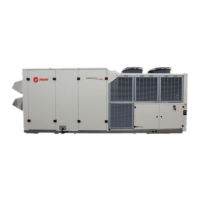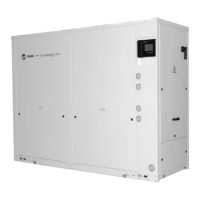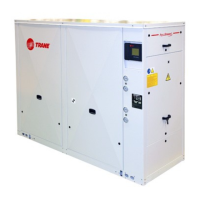AC-SVX003A-EN
101
Table 29. Diagnostics — AFD (continued)
Diagnostic
Name and
Source
Affects
Target
Severity
Persistence
Active Modes
[Inactive
Modes]
Criteria
Reset
Level
Controller
AFD
(a)
AFD Over
Temperature - xA
Cprsr
Immediate NonLatch
Momentary
NonLatch
Running
TR200 Alarm Code (A10), Alarm Word:
1, Bit: 8, Dec: 256
According to the electronic thermal
protection (ETR), the motor is too hot. The
fault is that the motor is overloaded by
more than 100% for too long.
Remote
AFD Short Circuit -
xA
Cprsr
Immediate Latch
Latch (Trip Lock)
All
TR200 Alarm Code (A16), Alarm Word:
1, Bit: 12, Dec: 4096
There is short-circuiting in the motor or on
the motor terminals.
Local
(a)
Latch (Trip Lock) - Requires reset command from the unit controller (via Modbus communication) or from TR200 keypad and power cycle of the drive to reset alarm.
Momentary NonLatch - Drive is programmed to automatically reset the alarm. If drive automatic reset sequence is exhausted, alarm will latch, requiring a manual reset.
NonLatch - True non-latching diagnostic where reset is not required to clear the alarm.
(b)
AFD General Fault - xA intentionally has the Controller Persistance set to NonLatch since this catch-all group that can have both latching and non-latching TR200 alarms.
The diagnostic will not be latched by the UC, but instead follow the AFD. AFD will protect itself and the compressor and will require a manual reset if needed.
(c)
AFD General Fault - xA Reset Level is set to Local, and Persistance is set to NonLatch to emphasize recommended user attention when an unexpected AFD alarm occurs.
Starter Diagnostics
Table 30. Diagnostics — Starter
Diagnostic
Name and
Source
Affects
Target
Severity
Persistence
Active Modes
[Inactive
Modes]
Criteria
Reset
Level
Motor Current
Overload - xB
Circuit Immediate Latch
Cprsr Energized
Compressor current exceeded overload time vs. trip
characteristic. Must trip = 140% RLA, Must hold=125%,
nominal trip 132.5% in 30 seconds
Local
Over Voltage
Chiller Normal NonLatch
Pre-Start and
Any Ckt(s)
Energized
Nom. trip: 60 seconds at greater than 112.5%, +/- 2.5%,
Auto Reset at 110% or less for 10 continuous seconds.
Remote
Phase Loss - xy Cprsr
Immediate Latch
Start Sequence
and Run modes
a) No current was sensed on one or two of the current
transformer inputs while running or starting (See Non-
latching Power Loss Diagnostic for all three phases lost
while running). Must hold = 20% RLA. Must trip = 5% RLA.
Time to trip shall be longer than guaranteed reset on Starter
Module at a minimum, 3 seconds maximum. Actual design
trip point is 10%. The actual design trip time is 2.64
seconds.
b) If Phase reversal protection is enabled and current is not
sensed on one or more current transformer inputs. Logic
will detect and trip in a maximum of 0.3 seconds from
compressor start.
Local
Phase Reversal -
xy
Cprsr
Immediate Latch
Compressor
energized to
transition
command
[All Other Times]
A phase reversal was detected on the incoming current. On
a compressor startup, the phase reversal logic must detect
and trip in a maximum of .3 second from compressor start.
Local
Diagnostics
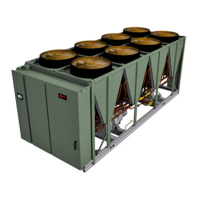
